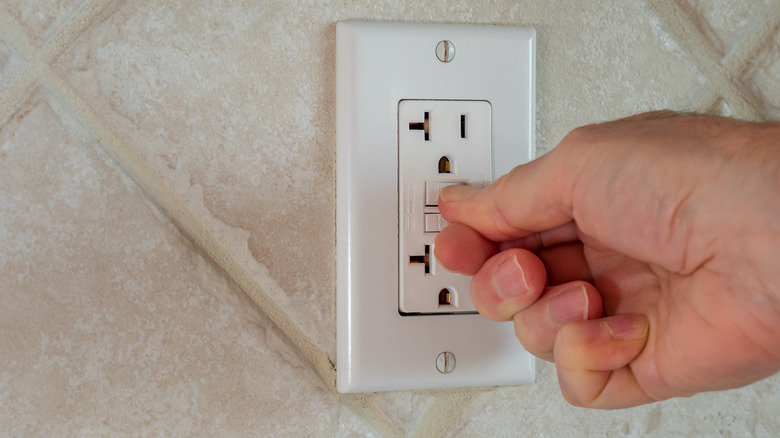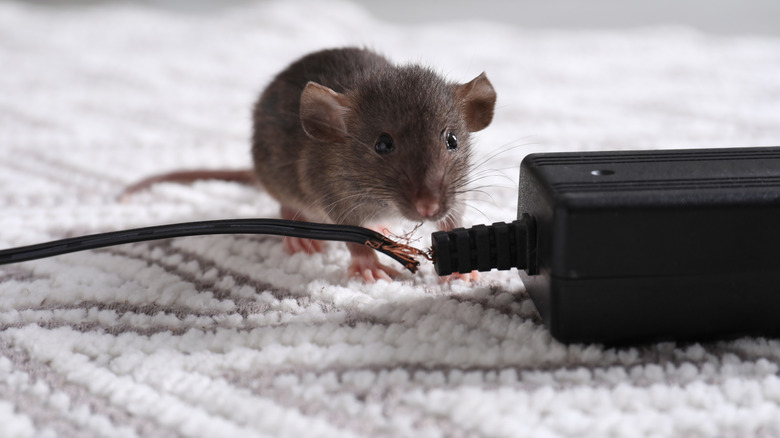What Is A GFCI Receptacle And Where Do You Need Them In Your Home?
Electricity is amazing. With it, you can power your car, keep your food cold, and print your selfies on toast. And when it stays inside walls, wires, and washing machines where we want it, electricity is like a modest superhero that takes care of everything from behind the scenes. But, like lightning, all it's really trying to do is find its way to the ground, and if you become that pathway to the earth, you could be in serious trouble. That's where GFCI-protected outlets come in to save us from electrocution by our single-minded hero. As a general rule, if moisture might be present, the NEC wants a GFCI-protected circuit in that room.
GFCI (Ground Fault Circuit Interrupter, sometimes also abbreviated GFI) devices are a type of electrical outlet commonly found in every home. They detect a difference in the amount of electricity flowing into and out of a circuit and shut it down when there's any chance the electricity has found an unintended path to ground, a "ground fault." This happens lightning-fast; a GFCI receptacle can shut down a circuit in less than a tenth of a second. If you happen to be the connection between a live electric wire and the ground (by standing on a damp concrete floor, for example), you'll usually feel a quick shock, and then the GFCI will sense all this and turn off the power.
How GFCI protects you
Loose or frayed wires, damaged equipment, and other problems can turn anything that conducts electricity into a dangerous live wire –- the metal casing of a washing machine, for example, or water on an outlet that's gotten wet. A GFCI device can protect an entire electrical circuit from this potential danger, but the GFCI device that's familiar to most people is the GFCI receptacle. These outlets have two buttons, one to test the GFCI and another to reset the circuit if it's been tripped by a fault. A GFCI receptacle can protect all the other outlets in a circuit, but it must come first on the circuit, closest to the circuit breakers and before any switches or other outlets. When a ground fault happens downstream from this first protected outlet, the GFCI shuts the circuit down until you fix the problem and press the reset button.
GFCI-protected circuit breakers have one advantage over receptacles: they protect the wiring between the breaker box and the first outlet from ground faults, while GFCI receptacles can't. But remember that ground faults aren't the only way to get shocked or start a fire. Also, keep in mind that short circuits are different from ground faults and will not necessarily trip a GFCI receptacle. While fuses, circuit breakers, and arc-fault circuit interrupters (AFCI) will give you some measure of protection, knowing the causes of short circuits and how to prevent them is essential.
Where you need GFCI protection in your home
Inside your home, many switches and outlets (including lights) require GFCI protection, according to the National Electrical Code (NEC), including in basements (finished or unfinished), bathrooms, boathouses, crawl spaces, garages, kitchens, laundry areas, and any outdoor outlets. GFCI is also required for any area with a sink or is likely to get damp or wet. If that seems like a lot to protect, consider that the Electrical Safety Foundation International says there has been an 83% drop in electrocutions (including a 95% drop in electrocutions caused by consumer products) since GFCI protection became available to American homes. Sometimes, GFCI protection isn't required where you expect it, such as circuits for smoke and fire alarms, sump pumps, and single-outlet receptacle circuits dedicated to some permanent appliances. This can vary by state, so check your local regulations.
Occassionally, specific appliances can have trouble with GFCI but they're not on the list of exceptions. Older GFCI devices had trouble with nuisance tripping (shutting down a circuit when there was no actual ground fault), especially when electric motors (refrigerators, fans, air compressors, garage door openers, etc.) were present on a circuit. Many homeowners report that they still experience this and other nuisance tripping. Consult with a licensed electrician if you are experiencing GFCI or other problems that can't be resolved without circumventing building codes.


